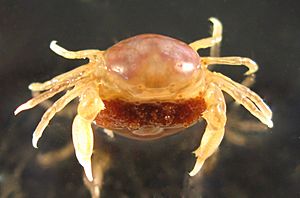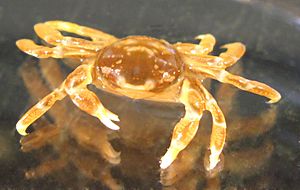New Zealand pea crab facts for kids
Quick facts for kids New Zealand pea crab |
|
|---|---|
 |
|
| Stage V adult Female New Zealand pea crab Nepinnotheres novaezelandiae | |
| Scientific classification | |
| Genus: |
Nepinnotheres
|
| Species: |
novaezelandiae
|
The New Zealand pea crab, Nepinnotheres novaezelandiae, is a tiny crab that often lives inside New Zealand green-lipped mussels. It's a parasite, meaning it lives off another animal. Adult female pea crabs are round, like a pea. Males are smaller and flatter. These crabs depend entirely on their mussel home for food and safety. They steal food from the mussel's gills. You can find New Zealand pea crabs all over New Zealand. They can live in up to 70% of wild mussel groups. These crabs can be a problem for mussel farms because they make mussels grow slower and smaller. But don't worry, mussels with pea crabs are still safe to eat!
Contents
What's in a Name?
This little crab was first described in 1885 by a scientist named Henri Filhol. He gave it the name Pinnotheres nova-zelandiae. Later, it was given a new name, Nepinnotheres, which is the genus it belongs to today.
What Does It Look Like?
Adult female New Zealand pea crabs have a soft outer shell, called an exoskeleton. Their main body, called the carapace, is oval. It can be from 9.3 to 20.2 millimeters wide. Females that are ready to have babies almost always carry eggs under their bodies. This makes them look even more round. Female crabs are a cloudy white color. As their eggs grow, they change color from red to orange to yellow. This gives the mother crab a different look at each stage.
Adult male New Zealand pea crabs have a hard outer shell. Their body is smaller and flatter than the female's. It measures from 3.2 to 11.8 millimeters wide. Male crabs are a creamy white color with special orange marks.
Where Do They Live and What Do They Eat?
Female New Zealand pea crabs stay in one mussel for their whole adult lives. Male crabs only leave their mussel home to find a mate. The male's hard, flat body helps it move around to find other mussels.
New Zealand pea crabs rely completely on their mussel home for food, safety, and a place to mate. The crab sits on the mussel's gills and takes food strands that the mussel has collected. This relationship is called parasitism. The crab harms the mussel by damaging its gills and stealing food. Mussels with crabs inside them grow slower and are smaller than mussels without crabs.
This crab is found only in New Zealand. It lives all over the country, including the North Island, South Island, Stewart Island, and the Chatham Islands. The New Zealand pea crab mostly lives in green-lipped mussels (Perna canaliculus). But it can also be found in other molluscs like the blue mussel (Mytilus edulis aoteanus), the Pacific oyster (Crassostrea gigas), and a type of clam (Chione stutchburyi). In wild mussel groups, anywhere from 0% to 70% of mussels might have a pea crab.
How Do They Find Mates?
Scientists studied how male crabs find female crabs in the dark. They used special infrared video cameras. When receptive female crabs were placed nearby, 60% of male crabs left their mussel homes to find them within 24 hours.
Males spent about 49 minutes exploring empty mussels. But once they found a mussel with a female inside, they never left! They spent about 200 minutes trying to get into the mussel. Male crabs were often seen gently touching the mussel's mantle edge. This helped them open the mussel's shell wider, from 3.7 to 5.5 millimeters. Scientists think that these crabs likely use special chemicals, called pheromones, to find mates. This helps them find females more safely.
Pea Crabs and Mussel Farms
Pea crabs are actually edible! People in the United States used to think they were a special treat. Even George Washington enjoyed pea crabs in his oyster soup. Mussels that have pea crabs inside them are also safe to eat.
However, the New Zealand pea crab can infect many mussels, from 5.3% to 70% of wild groups. This is a concern for farms that grow green-lipped mussels. These crabs can make mussels grow up to 29% smaller and slower. This means less mussels for farmers to sell.


